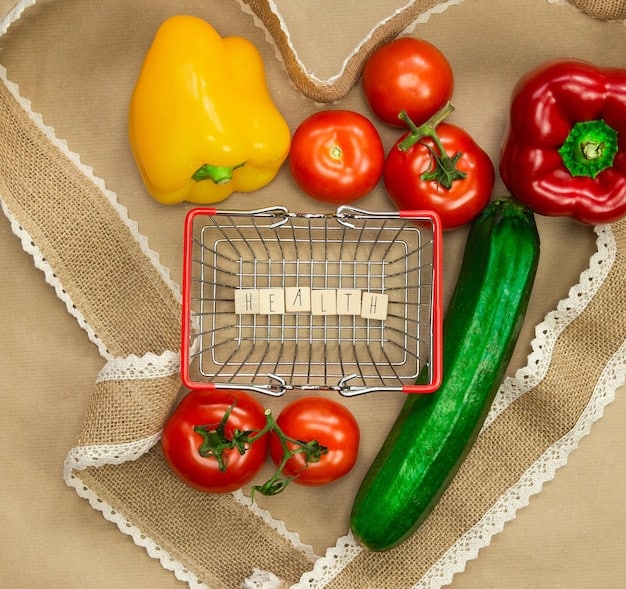Grocery Store Tricks: How to Save Money and Avoid Marketing Traps

Don’t Fall for These Tricks: Common Grocery Store Marketing Tactics and How to Avoid Them explores the deceptive strategies supermarkets use to encourage overspending, offering practical tips on how to shop smarter and keep more money in your pocket.
Ever wonder why you always spend more than you planned at the grocery store? This article dives into Don’t Fall for These Tricks: Common Grocery Store Marketing Tactics and How to Avoid Them, helping you become a savvy shopper.
Understanding Grocery Store Psychology
Grocery stores are designed to make you spend money. From the moment you walk in, every aspect of the store layout and product placement is carefully orchestrated to influence your purchasing decisions.
Understanding these tactics is the first step in taking control of your grocery shopping and saving money. By recognizing the psychological techniques at play, you can make more informed choices and avoid impulse buys.
The Power of Placement
Grocery stores strategically place certain items to grab your attention. End-of-aisle displays and eye-level shelves are prime real estate for products that the store wants you to notice.
- End-of-Aisle Displays: Often feature promotional items or seasonal goods, tempting you with deals and impulse purchases.
- Eye-Level Placement: More expensive and heavily marketed brands are typically placed at eye level to catch your attention.
- Kids’ Eye Level: Sugary cereals and snacks are frequently placed at a lower level where children can easily see them, leading to pester power.
By being aware of these placement strategies, you can consciously look for better deals and healthier options on higher or lower shelves.
In conclusion, understanding the psychology behind grocery store layouts and product placement can empower you to make smarter shopping decisions, resisting the urge to overspend and opting for more cost-effective and healthier choices.
The Perimeter Strategy: Shop the Edges
A common piece of advice for smart grocery shopping is to “shop the perimeter” of the store. This area typically houses fresh produce, dairy, meat, and bakery items. But why is this a good strategy?
Shopping the perimeter can help you focus on whole, unprocessed foods, which are often healthier and more cost-effective than packaged goods found in the center aisles.

Avoiding the Center Aisles
The center aisles are where you’ll find most processed foods, snacks, and packaged goods. These items tend to be more expensive and less nutritious than whole foods.
- Processed Foods: Often contain added sugars, unhealthy fats, and preservatives that can be detrimental to your health.
- Snack Foods: Can be tempting but are usually high in calories and low in nutritional value.
- Packaged Goods: May seem convenient but often come with a higher price tag than their fresh counterparts.
By minimizing your time in the center aisles, you can avoid many of the marketing traps designed to make you reach for these less healthy and more expensive options.
Therefore, focusing on the perimeter strategy can lead to healthier eating habits and significant savings on your grocery bill by prioritizing fresh, whole foods and minimizing exposure to processed and packaged goods.
Beware of “Sales” and Discounts
Everyone loves a good deal, but not all sales and discounts are created equal. Grocery stores use a variety of tactics to make you believe you’re saving money, even when you’re not.
It’s important to critically evaluate sales and discounts to ensure you’re actually getting a good value and not falling for a marketing ploy.
The Illusion of Savings
“Buy one, get one free” (BOGO) offers and other promotions can be tempting, but they often encourage you to buy more than you need. Consider whether you would have purchased the item at all if it weren’t on sale.
- BOGO Offers: May lead to food waste if you can’t use the extra item before it expires.
- Limited-Time Offers: Create a sense of urgency, pressuring you to buy impulsively.
- Discounted Prices: Can still be higher than the regular price of a similar item from a different brand.
Always compare the unit price (price per ounce or pound) to determine the true cost of an item, regardless of the discount.
In summary, while sales and discounts can be enticing, it’s crucial to approach them with a critical eye, comparing unit prices and considering your actual needs to avoid overspending and falling victim to manipulative marketing tactics.

The Power of Store Layout and Ambiance
Grocery stores are designed to be visually appealing and create a pleasant shopping experience. This is no accident – the layout and ambiance are carefully crafted to encourage you to spend more time (and money) in the store.
From the placement of flowers at the entrance to the music playing in the background, every detail is designed to influence your mood and behavior.
Sensory Marketing
Stores use sensory marketing techniques to engage your senses and make you feel comfortable. This can include:
- Pleasant Music: Slow-tempo music can encourage you to linger longer and browse more items.
- Aromas: The smell of freshly baked bread or roasting chickens can stimulate your appetite and make you more likely to buy food.
- Lighting: Warm, inviting lighting can create a relaxed atmosphere, making you more receptive to spending.
Being aware of these sensory tactics can help you stay focused on your shopping list and avoid impulse purchases driven by your emotions.
Essentially, understanding how store layout and ambiance influence your sensory experience can help you stay focused on your shopping list and avoid emotional impulse purchases, leading to a more budget-conscious grocery shopping trip.
Create a Shopping List and Stick to It
One of the most effective strategies for avoiding grocery store marketing tricks is to create a shopping list before you go and stick to it rigorously. This helps you stay focused and avoid impulse purchases.
A well-planned shopping list can be a powerful tool for maintaining control over your spending and ensuring you only buy what you actually need.
Planning Your Meals
Before creating your shopping list, take some time to plan your meals for the week. This will help you identify exactly what ingredients you need and avoid buying items you won’t use.
- Check Your Pantry: Take inventory of what you already have to avoid buying duplicates.
- Plan Your Meals: Decide what you’ll be eating for each meal to determine the necessary ingredients.
- Organize Your List: Group items by category to make your shopping trip more efficient and less prone to impulse buys.
By planning your meals and creating a detailed shopping list, you can significantly reduce the likelihood of overspending at the grocery store.
In conclusion, creating a shopping list based on well-planned meals ensures focused buying, prevents duplicate purchases, and ultimately helps maintain control over grocery spending by minimizing impulse buys.
Embrace Generic Brands and Bulk Buying
Generic or store brands are often significantly cheaper than name-brand products, and they often offer comparable quality. Embracing generic brands and buying in bulk when it makes sense can lead to substantial savings over time.
These strategies require a bit of research and planning, but the potential cost savings can be well worth the effort.
The Value of Generic Brands
Generic brands typically cost less because they don’t have the same marketing and advertising expenses as name-brand products. In many cases, they are produced in the same facilities and offer the same quality.
- Compare Ingredients: Check the ingredient lists to ensure the generic brand is similar to the name brand.
- Read Reviews: See what other shoppers have to say about the quality and taste of the generic brand.
- Try It Yourself: Don’t be afraid to experiment with different generic brands to find your favorites.
By switching to generic brands, you can save a significant amount of money without sacrificing quality or taste.
Therefore, embracing generic brands by comparing ingredients, reading shopper reviews, and experimenting with different options can lead to significant savings without compromising on product quality or taste.
Conclusion
By understanding and avoiding these common grocery store marketing tactics, you can take control of your spending and save money on your grocery bill. Shop smart, plan ahead, and be aware of the psychological tricks at play – your wallet will thank you!
| Key Point | Brief Description |
|---|---|
| 🧠 Understand Store Psychology | Recognize tactics like placement and ambiance to avoid impulse buys. |
| 🛒 Shop with a List | Plan meals and create a detailed list to stay focused and avoid overspending. |
| 🏷️ Compare Prices | Check unit prices and compare brands to find the best deals. |
| 💰 Buy Generic & Bulk | Opt for store-brand products and bulk purchases to save money. |
Frequently Asked Questions
▼
Milk, a staple item, is placed in the back to make customers walk through the store, increasing the likelihood of impulse purchases along the way. This strategic placement maximizes exposure to other products.
▼
Not always. BOGO (Buy One Get One Free) deals are only worth it if you need two of the item and would have bought it anyway. Otherwise, they can lead to unnecessary spending and potential waste.
▼
Create a detailed shopping list, stick to the perimeter of the store where fresh foods are, and avoid shopping when you’re hungry. Mindfulness helps you resist unplanned purchases effectively.
▼
Unit pricing is the cost per ounce, pound, or other standard unit of measure. Comparing unit prices helps you determine the best value, even when products come in different sizes or have varying discounts.
▼
Often, yes. Store brands frequently match the quality of name brands but at a lower cost. Check the ingredients and reviews to ensure they meet your standards and save money without sacrificing quality.
Conclusion
Mastering grocery shopping involves understanding store layouts, evaluating deals critically, and planning your shopping trips. By implementing these strategies, you can avoid marketing traps and significantly reduce your grocery expenses.





